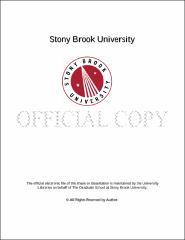| dc.identifier.uri | http://hdl.handle.net/11401/76664 | |
| dc.description.sponsorship | This work is sponsored by the Stony Brook University Graduate School in compliance with the requirements for completion of degree. | en_US |
| dc.format | Monograph | |
| dc.format.medium | Electronic Resource | en_US |
| dc.language.iso | en_US | |
| dc.publisher | The Graduate School, Stony Brook University: Stony Brook, NY. | |
| dc.type | Dissertation | |
| dcterms.abstract | Dileptons are emitted throughout the entire space-time evolution of heavy ion collisions. Being colorless, these electromagnetic probes do not participate in the final-state strong interactions during the passage through the hot medium, and retain the information on the conditions of their creation. This characteristic renders them valuable tools for studying the properties of the Quark Gluon Plasma created during ultra-relativistic heavy ion collisions. The invariant mass spectra of dileptons contain a wealth of information on every stage of the evolution of heavy ion collisions. At low mass, dilepton spectra consist mainly of light meson decays. The medium modification of the light vector mesons gives insight on the chiral symmetry restoration in heavy ion collisions. At intermediate and high mass, there are significant contributions from charm and bottom, with a minor contribution from QGP thermal radiation. The region was utilized to measure cross sections of open charm and open bottom, as well as quarkonium suppression as demonstrated by PHENIX. An earlier PHENIX measurement of dielectron spectra in heavy ion collisions, using data taken in 2004, shows significant deviations from the hadronic decay expectations. The measurement, however, suffered from an unfavorable signal to background ratio. Random combination of electron-positron pairs from unrelated sources, mostly Dalitz decay of $\pi^0$ and external conversion of decay photon to electrons, is the main contributor to the background. Mis-identified hadrons are another major background source. To improve the situation, the Hadron Blind Detector (HBD), a windowless proximity focusing Cerenkov detector, is designed to reduce this background by identifying electron tracks from photon conversions and $\pi^0$ Dalitz decays. The detector has been installed and operated in PHENIX in 2009 and 2010, where reference p$+$p and Au$+$Au data sets were successfully taken. We will present the dielectron results from the analysis of the Au$+$Au collisions, and compare the measured mass spectra to theoretical expectations. | |
| dcterms.available | 2017-09-20T16:50:54Z | |
| dcterms.contributor | Jacak, Barbara V | en_US |
| dcterms.contributor | Teaney, Derek | en_US |
| dcterms.contributor | Drees, Axel | en_US |
| dcterms.contributor | McCarthy, Robert | en_US |
| dcterms.contributor | David, Gabor | en_US |
| dcterms.contributor | . | en_US |
| dcterms.creator | Sun, Jiayin | |
| dcterms.dateAccepted | 2017-09-20T16:50:54Z | |
| dcterms.dateSubmitted | 2017-09-20T16:50:54Z | |
| dcterms.description | Department of Physics | en_US |
| dcterms.extent | 221 pg. | en_US |
| dcterms.format | Application/PDF | en_US |
| dcterms.format | Monograph | |
| dcterms.identifier | http://hdl.handle.net/11401/76664 | |
| dcterms.issued | 2016-12-01 | |
| dcterms.language | en_US | |
| dcterms.provenance | Made available in DSpace on 2017-09-20T16:50:54Z (GMT). No. of bitstreams: 1
Sun_grad.sunysb_0771E_12785.pdf: 15207685 bytes, checksum: 8c72bffeed534baac5cbcf068a50bbca (MD5)
Previous issue date: 1 | en |
| dcterms.publisher | The Graduate School, Stony Brook University: Stony Brook, NY. | |
| dcterms.subject | dielectron, Hadron Blind Detector, Heavy ion collisions, PHENIX experiment, Quark Gluon Plasma | |
| dcterms.subject | Nuclear physics and radiation | |
| dcterms.title | Measurement of Dielectron Invariant Mass Spectra in $Au+Au$ Collisions at $\sqrt{s_{NN}}=200GeV$ with HBD in PHENIX | |
| dcterms.type | Dissertation | |

